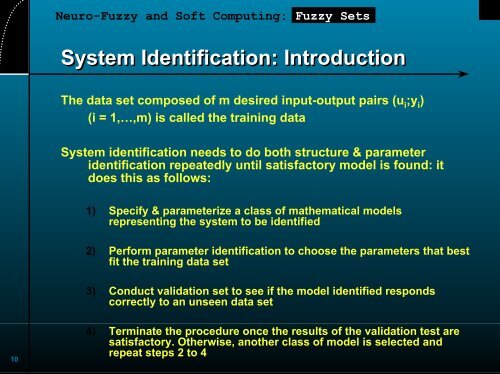Slides for Fuzzy Sets, Ch. 2 of Neuro-Fuzzy and Soft Computing
Slides for Fuzzy Sets, Ch. 2 of Neuro-Fuzzy and Soft Computing
Slides for Fuzzy Sets, Ch. 2 of Neuro-Fuzzy and Soft Computing
You also want an ePaper? Increase the reach of your titles
YUMPU automatically turns print PDFs into web optimized ePapers that Google loves.
<strong>Neuro</strong>-<strong>Fuzzy</strong> <strong>and</strong> S<strong>of</strong>t <strong>Computing</strong>: <strong>Fuzzy</strong> <strong>Sets</strong><br />
System Identification: Introduction<br />
The data set composed <strong>of</strong> m desired input-output pairs (u i<br />
;y i<br />
)<br />
(i = 1,…,m) is called the training data<br />
System identification needs to do both structure & parameter<br />
identification repeatedly until satisfactory model is found: it<br />
does this as follows:<br />
1) Specify & parameterize a class <strong>of</strong> mathematical models<br />
representing the system to be identified<br />
2) Per<strong>for</strong>m parameter identification to choose the parameters that best<br />
fit the training data set<br />
3) Conduct validation set to see if the model identified responds<br />
correctly to an unseen data set<br />
10<br />
4) Terminate the procedure once the results <strong>of</strong> the validation test are<br />
satisfactory. Otherwise, another class <strong>of</strong> model is selected <strong>and</strong><br />
repeat steps 2 to 4

















